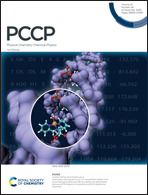Subpicosecond HI elimination in the 266 nm photodissociation of branched iodoalkanes†
Abstract
The 266 nm photodissociation dynamics of 1-iodopropane and 2-iodopropane were studied using photofragment translational energy spectroscopy using vacuum ultraviolet (VUV) photoionization and electron impact ionization detection of products. The photochemistry of 1-iodopropane was found to be similar to that of iodomethane and iodoethane, with dominant production of I*(2P1/2), and no evidence (<0.21%) for HI + alkene formation. Significantly different behavior was observed for 2-iodopropane, with dominant production of ground state I(2P3/2), and a HI yield >10.5%. The anisotropy (β) parameters for all channels approached the limiting value of 2.0, indicating that 1,2-HI elimination occurs on subpicosecond timescales, like direct C–I bond fission, following excitation to 3Q0. The HI translational energy and angular distributions were similar to those for I(2P3/2), suggesting that motion of the heavy I atom in HI is largely derived from the repulsive nature of the 1Q1 surface correlating to R + I with the light H atom picked up by ground state I late in the exit channel producing highly vibrationally excited HI.



 Please wait while we load your content...
Please wait while we load your content...
